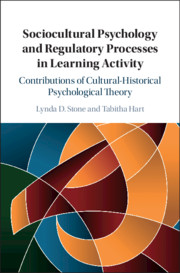 Sociocultural Psychology and Regulatory Processes in Learning Activity
Sociocultural Psychology and Regulatory Processes in Learning Activity Book contents
- Sociocultural Psychology and Regulatory Processes in Learning Activity
- Sociocultural Psychology and Regulatory Processes in Learning Activity
- Copyright page
- Dedication
- Contents
- Figures
- Transcription Excerpts
- Foreword
- Acknowledgments
- Transcription Conventions
- Introduction
- Chapter 1 Cultural-Historical Psychological Theory
- Chapter 2 The Relational Habitus and Regulatory Processes
- Chapter 3 Practical-Moral Knowledge and Regulatory Processes
- Chapter 4 Identity and Competence Woven Together Through Regulatory Processes
- Chapter 5 Contextual Mood and Regulatory Processes
- Conclusion
- References
- Index
Chapter 5 - Contextual Mood and Regulatory Processes
Published online by Cambridge University Press: 30 September 2019
- Sociocultural Psychology and Regulatory Processes in Learning Activity
- Sociocultural Psychology and Regulatory Processes in Learning Activity
- Copyright page
- Dedication
- Contents
- Figures
- Transcription Excerpts
- Foreword
- Acknowledgments
- Transcription Conventions
- Introduction
- Chapter 1 Cultural-Historical Psychological Theory
- Chapter 2 The Relational Habitus and Regulatory Processes
- Chapter 3 Practical-Moral Knowledge and Regulatory Processes
- Chapter 4 Identity and Competence Woven Together Through Regulatory Processes
- Chapter 5 Contextual Mood and Regulatory Processes
- Conclusion
- References
- Index
Summary
Chapter 5 offers a novel approach to emotion with the concept of contextual mood. In contrast to individualistic notions, mood is defined as emerging from socially distributed, interactive mechanisms, which, in turn, create and sustain moods in the lived experiences of learning practices. Contextual mood as a conceptual frame makes it possible to observe and capture how emotional (affective) experiences are interwoven with cognitive engagement in learning activities. In these activities, feelings permeate actions and thoughts and emerge through stancetaking, a linguistic resource used during social interactions. The creation of a contextual mood attunes learners to particular forms of behavioral regulation as learning activities unfold. We explain how a contextual mood prompts learners to consider, utilize, and potentially contribute to a repertoire of strategies for regulating meaning-making behaviors during literacy learning.
Keywords
- Type
- Chapter
- Information
- Sociocultural Psychology and Regulatory Processes in Learning ActivityContributions of Cultural-Historical Psychological Theory, pp. 87 - 106Publisher: Cambridge University PressPrint publication year: 2019


